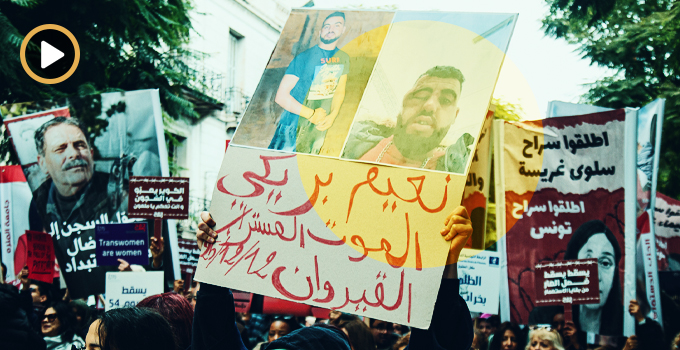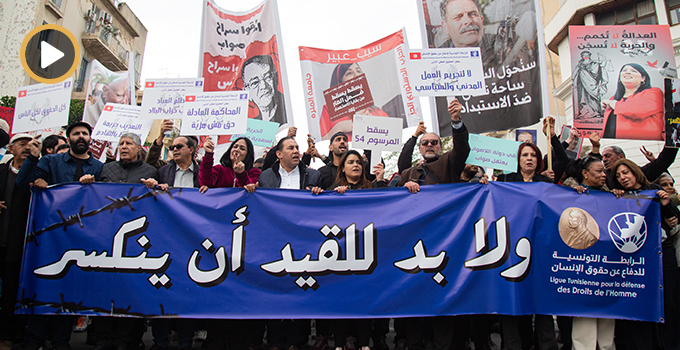In Lac 1, a chic neighborhood of northern Tunis, impeccably dressed employees and gleaming office buildings border the makeshift camps where hundreds of Sudanese refugees and other immigrants face a day-to-day struggle to survive.
It is January 25, an ordinary day in Lac 1 where a thin air of calm hovers above the simmering tensions that pervade this camp just outside the International Organization for Migration (OIM). “Are you the police?” one immigrant asks us with anger in his voice.

“Some people come to take pictures, which they then post on social media to make fun of us,” says another young man. According to denizens of the camp, police officers dressed in street clothes comb through the area making arrests.

Others regard us with indifference as they warm their hands around a crude campfire.
Exodus of Sudanese nationals
Another camp populated by Sudanese refugees has been erected in the public garden across the street. Sheet metal tents, tarps and used blankets are spread across the ground. Here exists a parallel universe with its own set of social and economic rules. The contrast with the neighborhood’s gleaming buildings and startup offices is glaring.
Denizens of the camp have come to fill the role of vendors, selling all kinds of products: cigarettes, fruit, clothes, shampoo. Their merchandise is spread across the ground. “Here at least, we don’t risk starving to death. We help one another, and products are cheaper than anywhere else,” Ahmed, a 21-year-old Sudanese refugee tells Nawaat.

Stepping foot into the camp, we are immediately surrounded by dozens of men. While migrants’ seething mistrust of the police is palpable, people here willingly share their stories, harrowing accounts of land border crossings. Their testimonies reveal the brutality of militia encountered along the way, incidents of rape and tensions with smugglers and border guards.
Residents of this camp are among the thousands of Sudanese refugees and asylum seekers to have arrived in Tunisia over the past several months. According to the United Nations High Commissioner for Refugees (HCR) in Tunisia who shared its last survey (dated January 14, 2024) with Nawaat, there are over 13 thousand refugees and asylum seekers in the country; 40% of these individuals are from Sudan.
In 2023, the HCR recorded 7,381 new asylum seekers, including 4,676 Sudanese nationals. A significant increase from the 868 Sudanese asylum seekers accounted for in 2022.
In the midst of a bloody war between the regular army of General Abdel Fattah al-Burhan and the paramilitary troops of the Rapid Support Forces (RSF) led by General Mohamed Hamdan Dagalo, known as Hemeti, Sudan’s population is fleeing the country.
According to the OIM, 7.7 million citizens have been displaced within Sudan, while over 1.2 million have sought refuge in other countries such as Chad, Ethiopia, Egypt, South Sudan, the Central African Republic and Libya.
A number of Sudanese refugees in the camp have come to Tunisia from Libya. Others made their way through Chad, Niger and then Algeria before arriving here.
Among them, 18-year-old Mustapha who arrived to Tunisia in October. Fleeing Geneina, the capital of West Darfur and epicenter of bloody clashes, Mustapha left behind everything he owned as well as the buried bodies of family members killed in conflict.

Before arriving in Tunisia, he passed through Chad, Niger and Algeria, sometimes traveling by foot. His friend Bechir, age 20, also left El Geneina for Libya. Bechir does not regret the 800 Libyan dinars turned over to a local smuggler in order to make his way to Tunisia; he is simply relieved to have escaped Libya where he languished in prison for over a month.
Hardship followed them into Tunisia, where the young men were often on foot as they made their way from the south of the country towards other cities. “Louage [vans providing regional transportation] drivers refuse to give us a ride,” recounts Mustapha. Many drivers fear police checks along the road. For months now, Tunisian authorities have been engaged in a campaign to expel migrants from the country.
A climate of fear has washed over Tunisia, to the extent that some citizens want nothing to do with migrants. Evicted from housing by landlords, dismissed by employers, many migrants are left to fend for themselves.
Even those more recently arrived to the country, having fled the war and obtained refugee status, are not spared from the hardship and discrimination endured by sub-Saharan migrants in Tunisia. Some of the young men we meet in the camp have recently been released from the Mornaguia prison, where they were detained on grounds of illegal entry into Tunisia. “I showed them my refugee card, but it didn’t make a difference to them,” one young man told us.
Tunisia, which signed the 1951 Geneva Refugee Convention, is bound to offer protection to refugees who have fled armed conflicts. “This protection includes facilitating access to work, shelter and a right to mobility,” says Romdhane Ben Amor, spokesman of the Tunisian Forum for Economic and Social Rights (FTDES), to Nawaat.

However, the reality faced by refugees in Tunisia is something else entirely. Lightly dressed and wearing plastic flip-flops, Bechir and Mustapha wander the neighborhood of Lac 1. “It’s a miracle that we survived our long journey across borders. But the future remains uncertain,” says Mustapha. And the present is harsh. “The garden is over-crowded. It’s hard to be there. But we don’t know where else to go,” he tells us.
Deplorable conditions
In this camp, one is deemed “lucky” to secure a tent and blankets. “Before, we could sleep directly on the ground under the shelter of surrounding buildings. But some landlords weren’t happy about this, and we were kicked out,” relates Ezzedine, a 21-year-old refugee from Sudan. In the middle of the garden, one man lays sleeping on a public bench, wrapped in a blanket from head to toe. Others sleep on sheets of cardboard which serve as mattresses.

While some are able to make do with whatever shelter they find, the same is not true for women and children. Few have managed to find a place in the camp. Among them, the 21-year old mother of a little boy. She is nine months pregnant, and cannot predict under what conditions she is soon to give birth. Her husband has just been released from the Mornaguia prison.
Her four-year-old son runs joyfully, and shoeless, in the garden. A young man helps the boy to relieve himself, guarded from plain view. There are neither toilets nor running water here, meaning that sanitary conditions are deplorable. “Even dogs deserve a more decent life,” Ezzeddine remarks.
One man has assumed the function of hairdresser. A dozen young men await their turn for a haircut. Others are busy washing clothes in old paint buckets. The scent of food cooking floats through the air, arising from little stoves where men are bent over pots as they stir large quantities of pasta and Ojja.

Some in the camp report that they receive a monthly sum of 350 from the HCR, which is not enough to cover their expenses. “How can I pay rent with this amount? Even the rare individuals among us who work sleep in the camp at night. They have no other options,” says Ahmed, a 24-year-old Sudanese man.
Many have yet to benefit from this monthly stipend. The filing procedure for refugees and asylum seekers is long, migrants inform us. They affirm that the waiting period for appointments with the HCR is drawn-out, sometimes taking up to six months. Some bide their time one cigarette after another, faces set in an expressionless gaze. Others project a more childlike insouciance as they kick a ball back and forth to one another.

The HCR explains that the long wait is due to its “lack of financing” and the massive influx of refugees. The organization’s communications department indicates that it is nevertheless “endeavoring” to ensure that refugees and asylum seekers are afforded protection in conformity with international law, including access to asylum procedures and basic services. Among others, these services entail shelter, legal assistance, psychosocial support and help towards autonomy.
For Romdhane Ben Amor, such protection is inadequate. This much, the FTDES spokesman points out, is apparent in the number of sit-ins staged outside HCR headquarters, with refugees and asylum seekers denouncing the shortcomings in services and care afforded them by the organization.
Overwhelmed as it is by the influx of new cases, the HCR cannot meet the demands of refugees without the support of Tunisian authorities. As the organization explains to Nawaat, Tunisia’s legal procedures make finding work, shelter and access to education extremely difficult for asylum seekers and refugees. Moreover, although Tunisia adheres in principle to the 1951 Geneva Refugee Convention, the country has yet to adopt a national asylum system.
As a result, Ben Amor tells Nawaat, Tunisia cannot be considered a “safe” country for refugees and asylum seekers. “This population must be resettled in another country, one that is safe and capable of guaranteeing their reintegration.”
The majority of Sudanese refugees we meet at the camp do not wish to remain in Tunisia. Many hope to depart by legal means to other countries through the HCR’s resettlement process. Precious few, however, will see this dream realized, the HCR’s communications department affirms.
“Only a limited number of refugees can have access to resettlement programs. The most vulnerable cases are organized in order of priority on the basis of case-by-case evaluation. For such cases, resettlement is the most appropriate long-term solution,” the HCR explains.
The organization also highlights that resettlement quotas are limited, and that resettlement “is not a solution for all refugees, but a vital protection mechanism for the individuals who are most vulnerable in countries of refuge.”
Less than 1% of refugees are resettled each year. Of the total 21.3 million refugees registered by the HCR worldwide, only 57,500 were resettled in 2021.
Sudanese refugees thus find themselves trapped in Tunisia, where a climate of hostility ignited by President Kais Saied stifles the country’s sub-Saharan immigrant population. In the absence of national reintegration policies, refugees in Tunisia seem fated to a miserable existence. Unless, that is, they opt once again for the perilous journey across country borders, this time pursuing their trajectory by sea.









iThere are no comments
Add yours